
|
Now it is so bright as 7.9 mag (May 24, Chris Wyatt). It will approach to the sun down to 0.66 a.u. in July, and it is expected to brighten up to 4-5 mag. It is already not observable in the Northern Hemisphere. It will be unobservable in early June also in the Southern Hemisphere. After the perihelion passage, it will be observable in excellent condition after late July in the Northern Hemisphere. In the Southern Hemisphere, it keeps unobservable until early September.
Date(TT) R.A. (2000) Decl. Delta r Elong. m1 Best Time(A, h)
May 24 6 48.89 7 5.9 1.523 1.036 42 7.1 20:44 ( 96, 3)
May 31 6 39.62 9 41.6 1.603 0.938 33 6.6 20:51 (105, -4)
|

|
Now it is bright as 8.2 mag (May 24, Chris Wyatt). The brightening is somewhat slow, but it is expected to brighten up to 6-7 mag in 2014 autumn. It keeps observable in good condition for a long time in the Northern Hemisphere. It keeps locating low in the Southern Hemisphere.
Date(TT) R.A. (2000) Decl. Delta r Elong. m1 Best Time(A, h)
May 24 11 18.54 45 42.0 1.572 1.837 87 8.7 20:44 (127, 69)
May 31 10 50.38 42 45.8 1.643 1.756 78 8.7 20:51 (116, 59)
|

|
It brightened rapidly in outburst in mid October. Now it is bright as 8.4 mag (May 10, Marco Goiato). It keeps 8-9 mag until July. In the Northern Hemishpere, it keeps observable in the morning sky until July. In the Southern Hemisphere, it keeps observable in good condition for a long time until the comet fades out.
Date(TT) R.A. (2000) Decl. Delta r Elong. m1 Best Time(A, h)
May 24 22 6.04 -16 55.4 1.645 2.005 94 8.7 3:09 (314, 24)
May 31 22 14.08 -19 16.8 1.615 2.060 100 8.8 3:04 (319, 24)
|

|
It passed only 0.4 A.U. from the earth, and 0.8 A.U. from the sun in November and December, and brightened up to 4.7 mag (Nov. 28, Juan Jose Gonzalez). Now it is 11.4 mag (May 4, Carlos Labordena). It keeps observable until 2014 autumn when the comet fades out.
Date(TT) R.A. (2000) Decl. Delta r Elong. m1 Best Time(A, h)
May 24 16 56.10 -20 49.7 1.568 2.566 167 11.4 0:53 ( 0, 34)
May 31 16 40.41 -22 17.4 1.640 2.653 177 11.6 0:09 ( 0, 33)
|

|
Now it is 13.4 mag (May 22, Chris Wyatt). It will approach to the earth down to 0.06 a.u. from May to June, and it is expected to brighten up to 11 mag. In the Northern Hemisphere, it will be getting lower very rapidly after this, and will be unobservable in early June. In the Southern Hemisphere, it will be getting higher very rapidly after this. Then it keeps observable in excellent condition at the highlight and after that while the comet will be fading.
Date(TT) R.A. (2000) Decl. Delta r Elong. m1 Best Time(A, h)
May 24 10 8.86 35 6.7 0.076 1.002 79 12.4 20:44 ( 97, 57)
May 31 11 3.61 -23 17.5 0.058 1.031 105 11.8 20:51 ( 32, 19)
|
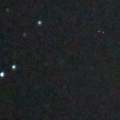
|
Cometary activity began. Now it is bright as 13.5 mag (May 7, A. Novichonok and T. Prystavski). It will brighten up to 7 mag in July, and will be observable in excellent condition in the Northern Hemisphere. In the Southern Hemisphere, it is not observable temporarily in mid July, but it is observable before and after mid July.
Date(TT) R.A. (2000) Decl. Delta r Elong. m1 Best Time(A, h)
May 24 1 9.14 -3 28.3 1.702 1.284 48 12.6 3:09 (274, -1)
May 31 1 7.55 -1 32.1 1.493 1.228 54 11.9 3:04 (275, 5)
|
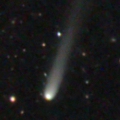
|
Now it is 14.3 mag (Mar. 30, Taras Prystavski). It is expected to brighten up to 7.5 mag and to be observable in excellent condition from summer to autumn in 2014 in the Southern Hemisphere. It keeps observable for a long time in the Southern Hemisphere, although it becomes low temporarily in May. It keeps unobservable for a while in the Northern Hemisphere. It will pass extremely close to Mars in 2014 October.
Date(TT) R.A. (2000) Decl. Delta r Elong. m1 Best Time(A, h)
May 24 3 1.40 -23 14.8 3.112 2.521 46 12.2 3:09 (276,-34)
May 31 3 4.99 -23 23.2 2.979 2.450 49 12.0 3:04 (278,-31)
|
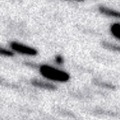
|
The condition in this apparition is bad. It locates low around the brightest days. Now it is not observable. It will appear in the morning sky at 13 mag in late July.
Date(TT) R.A. (2000) Decl. Delta r Elong. m1 Best Time(A, h)
May 24 3 8.81 15 27.0 2.623 1.656 13 12.2 3:09 (240,-13)
May 31 3 29.50 16 22.8 2.611 1.655 15 12.2 3:04 (240,-12)
|

|
New outburst occured on May 2, and it brightened up to 13.0 mag (May 3, Seiichi Yoshida). Another outburst occured on May 12, and it brightened up to 12.7 mag (May 12, Con Stoitsis). Now it looks diffuse, but still bright as 12.8 mag (May 22, Chris Wyatt).
Date(TT) R.A. (2000) Decl. Delta r Elong. m1 Best Time(A, h)
May 24 15 36.04 -30 21.9 5.144 6.140 168 13.5 23:28 ( 0, 25)
May 31 15 32.60 -30 7.6 5.155 6.138 164 13.5 22:57 ( 0, 25)
|
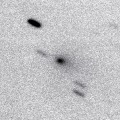
|
It brightened up to 2 mag by unusual major outburst in 2007. It is coming back now. It will be 14 mag at best by normal prediction. But actually, it is already very bright as 13.5 mag (Nov. 25, Hidetaka Sato). Appearing in the morning sky. In the Northern Hemisphere, it keeps observable until it fades out in 2015. In the Southern Hemisphere, it keeps extremely low after this.
Date(TT) R.A. (2000) Decl. Delta r Elong. m1 Best Time(A, h)
May 24 1 30.22 20 25.9 2.847 2.105 35 13.6 3:09 (251, 9)
May 31 1 44.35 22 23.4 2.817 2.118 38 13.7 3:04 (250, 11)
|

|
Now it is 15.2 mag (Apr. 7, Katsumi Yoshimoto). It keeps bright as 13-14 mag for a long time from 2013 to 2014.
Date(TT) R.A. (2000) Decl. Delta r Elong. m1 Best Time(A, h)
May 24 21 4.99 -25 34.8 2.556 3.070 111 13.8 3:09 (333, 24)
May 31 21 7.90 -25 50.8 2.475 3.073 117 13.7 3:04 (337, 25)
|
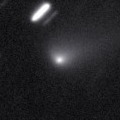
|
Now it is bright as 13.4 mag (May 21, Mitsunori Tsumura). It keeps observable at 13 mag in excellent condition from spring to summer.
Date(TT) R.A. (2000) Decl. Delta r Elong. m1 Best Time(A, h)
May 24 13 50.01 -8 57.1 1.668 2.571 146 13.8 21:42 ( 0, 46)
May 31 13 49.80 -8 45.6 1.718 2.573 139 13.9 21:14 ( 0, 46)
|

|
Brightened rapidly. Now it is 14.0 mag (Mar. 28, Sandor Szabo). It will brighten up to 13-14 mag and will be observable in excellent condition from spring to summer in the Southern Hemisphere. It locates somewhat low in the Northern Hemispehre.
Date(TT) R.A. (2000) Decl. Delta r Elong. m1 Best Time(A, h)
May 24 9 24.94 -16 7.2 1.698 1.936 87 13.9 20:44 ( 53, 19)
May 31 9 41.62 -15 40.0 1.730 1.927 84 13.9 20:51 ( 56, 17)
|

|
Now it is 13.3 mag (Apr. 28, Taras Prystavski). It keeps bright at 13-14 mag for a long time until 2014.
Date(TT) R.A. (2000) Decl. Delta r Elong. m1 Best Time(A, h)
May 24 19 42.47 3 34.0 5.868 6.445 120 14.0 3:09 (347, 58)
May 31 19 38.00 3 15.6 5.794 6.465 127 14.0 3:04 (359, 58)
|
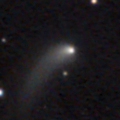
|
Now it is 14.2 mag (May 19, Sandor Szabo). It keeps 14 mag for a long time until 2014 summer. It keeps observable in good condition in the Northern Hemisphere. It keeps unobservable after this in the Southern Hemisphere.
Date(TT) R.A. (2000) Decl. Delta r Elong. m1 Best Time(A, h)
May 24 5 57.66 64 13.5 2.228 1.717 47 14.1 20:44 (152, 26)
May 31 6 39.64 65 53.3 2.237 1.743 48 14.2 20:51 (153, 28)
|

|
Now it is very bright as 12.9 mag (Apr. 30, Taras Prystavski). It brightened up to 9 mag at the discovery in 2005. It will approach to the sun down to 0.8 a.u. on May 29. However, it will brighten up to 13-14 mag at best. In this apparition, it keeps observable in the morning sky all through the period. But it locates extremely low around the perihelion passage in the Northern Hemisphere.
Date(TT) R.A. (2000) Decl. Delta r Elong. m1 Best Time(A, h)
May 24 0 56.17 3 16.4 1.014 0.831 48 14.2 3:09 (270, 6)
May 31 1 29.79 6 6.7 1.080 0.826 46 14.3 3:04 (266, 5)
|

|
It brightened up to 11-12 mag in 2012. Now it is 14.5 mag (Apr. 30, Sandor Szabo). It will be observable in good condition at 14 mag until 2014 early summer.
Date(TT) R.A. (2000) Decl. Delta r Elong. m1 Best Time(A, h)
May 24 11 58.89 -7 55.7 7.043 7.602 120 14.2 20:44 ( 19, 45)
May 31 11 55.98 -7 34.7 7.189 7.637 112 14.2 20:51 ( 31, 42)
|
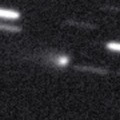
|
Now it is 14.9 mag (Apr. 18, Taras Prystavski). It is expected to brighten up to 5 mag in 2014 autumn. Now it is not observable. It will be observable again in July in the Southern Hemisphere, or in August in the Northern Hemisphere.
Date(TT) R.A. (2000) Decl. Delta r Elong. m1 Best Time(A, h)
May 24 5 4.74 17 44.4 3.279 2.316 15 14.7 20:44 (120,-10)
May 31 5 8.81 17 31.0 3.211 2.220 10 14.5 20:51 (125,-15)
|
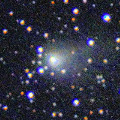
|
First return of a new periodic comet discovered in 1998. It brightened up to 10 mag at the discovery, but it brightened up to 11-12 mag at best in this apparition. Now it is 13.3 mag (May 19, Sandor Szabo). It will be fading after this. It will be unobservable in mid June. In the Southern Hemisphere, it keeps observable until August.
Date(TT) R.A. (2000) Decl. Delta r Elong. m1 Best Time(A, h)
May 24 8 28.35 10 40.1 2.504 2.261 64 14.6 20:44 ( 85, 26)
May 31 8 40.96 9 24.7 2.589 2.281 61 14.7 20:51 ( 87, 21)
|

|
Now it is bright as 13.1 mag (May 7, Taras Prystavski). It keeps 13-14 mag and observable in good condition in the Northern Hemisphere for a long time from 2013 to 2014. In the Southern Hemisphere, it is not observable until 2014 autumn.
Date(TT) R.A. (2000) Decl. Delta r Elong. m1 Best Time(A, h)
May 24 1 16.51 51 49.6 4.361 3.709 44 14.7 3:09 (224, 26)
May 31 1 18.98 51 58.0 4.344 3.733 47 14.7 3:04 (225, 29)
|

|
Now it is 13.3 mag and already visible visually (May 3, Seiichi Yoshida). It is expected to brighten up to 13 mag and to be observable in good condition in 2015. In 2014, it keeps observable in good condition from winter to summer.
Date(TT) R.A. (2000) Decl. Delta r Elong. m1 Best Time(A, h)
May 24 13 37.21 0 41.4 3.682 4.492 138 14.9 21:29 ( 0, 56)
May 31 13 35.83 0 48.0 3.713 4.453 131 14.8 21:00 ( 0, 56)
|

|
Big asteroid discovered in 1906. It suddenly showed the cometary activity on Dec. 11, 2010, probably due to an impact of a small object. It has already turned to be stellar.
Date(TT) R.A. (2000) Decl. Delta r Elong. m1 Best Time(A, h)
May 24 3 1.48 11 12.3 4.296 3.343 17 15.1 3:09 (245,-14)
May 31 3 10.32 11 58.1 4.270 3.348 21 15.2 3:04 (246,-11)
|
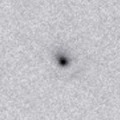
|
Now it is not observable. In the Northern Hemisphere, it will appear in the morning sky in late July. Then it will be observable at 12-13 mag in excellent condition from 2014 summer to 2015 spring. In the Southern Hemisphere, it will locate low around the highlight.
Date(TT) R.A. (2000) Decl. Delta r Elong. m1 Best Time(A, h)
May 24 3 39.76 19 9.3 3.388 2.382 5 15.2 3:09 (232,-16)
May 31 3 54.19 20 11.1 3.348 2.350 8 15.1 3:04 (233,-14)
|
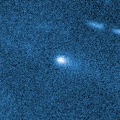
|
Now it is 15.8 mag (May 6, A. Maury, J.-G. Bosch, J.-F. Soulier, T. Noel). It keeps 15-16 mag until August. But it keeps low for a while.
Date(TT) R.A. (2000) Decl. Delta r Elong. m1 Best Time(A, h)
May 24 1 54.59 10 15.7 2.227 1.475 32 15.5 3:09 (256, -2)
May 31 2 16.46 11 58.4 2.204 1.469 33 15.4 3:04 (255, -1)
|
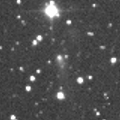
|
Now it is 15.2 mag (Apr. 22, Taras Prystavski), brighter than origianlly predicted. It will be observable at 14-16 mag for a long time from 2013 to 2014.
Date(TT) R.A. (2000) Decl. Delta r Elong. m1 Best Time(A, h)
May 24 16 0.88 -25 16.9 3.170 4.180 175 15.7 23:52 ( 0, 30)
May 31 15 56.69 -25 13.2 3.190 4.195 171 15.8 23:21 ( 0, 30)
|

|
Not been observed yet in this apparition. But it should be already bright as 16 mag. In the Southern Hemisphere, it has already appeared in the morning sky. In the Northern Hemisphere, it is not observable until early July. But it will be observable in good condition after that while the comet will be fading gradually. In the Southern Hemisphere, it keeps extremely low.
Date(TT) R.A. (2000) Decl. Delta r Elong. m1 Best Time(A, h)
May 24 2 10.08 4 1.5 2.429 1.658 31 16.1 3:09 (259, -9)
May 31 2 28.22 6 22.1 2.383 1.634 33 15.9 3:04 (257, -7)
|

|
Brightening rapidly. Now it is 15.7 mag (Apr. 22, Taras Prystavski). It will start fading after June, and will be fainter than 18 mag in August.
Date(TT) R.A. (2000) Decl. Delta r Elong. m1 Best Time(A, h)
May 24 13 51.24 -14 50.2 1.212 2.141 148 16.4 21:43 ( 0, 40)
May 31 13 48.32 -15 45.9 1.255 2.142 141 16.5 21:13 ( 0, 39)
|

|
Not been observed yet in this apparition. But it should be already bright as 16.5 mag. It is observable in morning low sky in the Southern Hemisphere. It will brighten up to 16 mag from May to June. In the Northern Hemisphere, it will become observable in July, when the comet will be fainter than 18 mag already.
Date(TT) R.A. (2000) Decl. Delta r Elong. m1 Best Time(A, h)
May 24 1 48.85 3 5.0 1.784 1.148 36 16.7 3:09 (263, -5)
May 31 2 14.28 6 36.7 1.779 1.132 36 16.4 3:04 (259, -4)
|
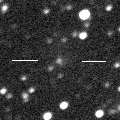
|
Now it is 17.9 mag (Mar. 9, W. Hasubick). Distant object, but it keeps observable at 14 mag for a long time from 2015 to 2016.
Date(TT) R.A. (2000) Decl. Delta r Elong. m1 Best Time(A, h)
May 24 19 19.94 -2 16.0 6.393 7.067 128 16.5 3:09 (358, 53)
May 31 19 18.79 -2 6.5 6.286 7.035 134 16.5 2:46 ( 0, 53)
|

|
It brightened up to 14.0 mag from spring to summer in 2013 (June 11, Sandor Szabo). Now it is 15.7 mag, much brighter than origianlly predicted (Apr. 24, Taras Prystavski). In the Northern Hemisphere, it will be observable at 15-16 mag in excellent condition until spring. It locates somewhat low in the Southern Hemisphere.
Date(TT) R.A. (2000) Decl. Delta r Elong. m1 Best Time(A, h)
May 24 11 34.48 36 34.8 4.533 4.728 94 16.8 20:44 (101, 74)
May 31 11 30.74 36 33.3 4.689 4.770 88 16.9 20:51 (102, 67)
|
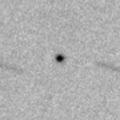
|
Now it is 16.1 mag (May 5, Taras Prystavski). It is expected to brighten up to 4-5 mag from autumn to winter in 2015. It already locates high in the Southern Hemisphere. It will be getting higher gradually also in the Northern Hemisphere. It is observable in good condition in the Southern Hemisphere until the highlight, or in the Northern Hemisphere after the highlight.
Date(TT) R.A. (2000) Decl. Delta r Elong. m1 Best Time(A, h)
May 24 0 0.62 -11 26.3 6.903 6.582 67 16.9 3:09 (290, 8)
May 31 0 2.02 -11 34.9 6.729 6.519 73 16.8 3:04 (293, 12)
|

|
Now it is 16.5 mag (Apr. 16, Taras Prystavski). It keeps 17 mag for a long time from 2014 to 2015. It is observable in excellent condition in the Northern Hemisphere. It is observable only until 2014 summer in the Southern Hemisphere.
Date(TT) R.A. (2000) Decl. Delta r Elong. m1 Best Time(A, h)
May 24 15 57.99 32 2.6 3.451 4.143 127 16.9 23:49 ( 0, 87)
May 31 15 53.64 33 6.3 3.464 4.122 124 16.8 23:17 ( 0, 88)
|

|
Now it is 17.5 mag (Apr. 5, N. James). It keeps observable at 18 mag for a long time from 2013 to 2016. It keeps locating high in the Northern Hemisphere. It keeps locating very low in the Southern Hemipshere.
Date(TT) R.A. (2000) Decl. Delta r Elong. m1 Best Time(A, h)
May 24 18 46.89 47 2.2 6.190 6.490 102 17.1 2:42 (180, 78)
May 31 18 39.28 48 5.8 6.160 6.486 104 17.1 2:07 (180, 77)
|
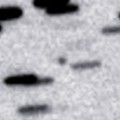
|
Now it is 16.1 mag (May 2, Mt. Lemmon Survey). It keeps 17-18 mag for a long time from 2014 to 2016.
Date(TT) R.A. (2000) Decl. Delta r Elong. m1 Best Time(A, h)
May 24 13 56.00 -11 17.8 4.729 5.617 148 17.1 21:47 ( 0, 44)
May 31 13 48.12 -11 4.7 4.788 5.601 139 17.1 21:12 ( 0, 44)
|

|
Now it is 18.0 mag (Apr. 30, Taras Prystavski). It was observed at 17.5 mag in early 2013. It will be observable at 17.5 mag again from spring to summer in 2014.
Date(TT) R.A. (2000) Decl. Delta r Elong. m1 Best Time(A, h)
May 24 19 44.69 -12 37.4 2.139 2.858 126 17.2 3:09 (350, 42)
May 31 19 44.34 -12 45.6 2.087 2.876 133 17.2 3:04 (357, 42)
|

|
It approached to the earth down to 0.68 a.u. in spring, and brightened up to 15.6 mag (Mar. 29, Taras Prystavski). Now it is fading. It has already faded down to 17.4 mag (May 3, P.-J. Dekelver). It will be fainter than 18 mag in June.
Date(TT) R.A. (2000) Decl. Delta r Elong. m1 Best Time(A, h)
May 24 10 44.57 -16 10.0 1.122 1.698 105 17.2 20:44 ( 36, 30)
May 31 10 51.59 -18 24.5 1.197 1.716 101 17.4 20:51 ( 41, 25)
|

|
Now it is 18.2 mag (Apr. 22, D. Herald). It keeps 17-18 mag for a long time from 2013 to 2014. It is observable in excellent condition in the Southern Hemisphere. It is not observable in the Northern Hemisphere.
Date(TT) R.A. (2000) Decl. Delta r Elong. m1 Best Time(A, h)
May 24 11 9.97 -55 8.5 4.167 4.707 116 17.3 20:44 ( 14, -3)
May 31 11 1.45 -54 1.9 4.239 4.714 112 17.4 20:51 ( 20, -4)
|
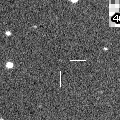
|
First return of a new periodic comet which brightened up to 13 mag in 2007. It was expected to brighten up to 13 mag again and observable in good condition from summer to autumn in 2014. But actually, it is 17.5 mag, much fainter than expected (Apr. 28, Taras Prystavski). It will be 16 mag at best actually.
Date(TT) R.A. (2000) Decl. Delta r Elong. m1 Best Time(A, h)
May 24 22 40.49 -6 4.8 2.292 2.394 83 17.5 3:09 (300, 27)
May 31 22 50.19 -5 31.4 2.199 2.380 87 17.4 3:04 (302, 29)
|
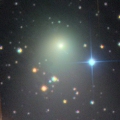
|
It became much brighter than expected, and reached up to 8.5 mag (Aug. 15, Alexandre Amorim). Now it is fading rapidly. It has already faded down to 17.5 mag (Apr. 23, K. Hills). In the Southern Hemisphere, it will keep observable in good condition for a long time until 2014 summer when the comet fades out. It will never be observable again in the Northern Hemisphere.
Date(TT) R.A. (2000) Decl. Delta r Elong. m1 Best Time(A, h)
May 24 14 59.07 -66 34.3 3.022 3.785 132 17.6 22:51 ( 0,-11)
May 31 14 48.39 -64 48.4 3.081 3.854 133 17.8 22:13 ( 0,-10)
|

|
Not been observed yet in this apparition. It will brighten very rapidly after this, and it is expected to reach up to 10 mag in August. It keeps observable in the morning sky until mid August while the comet will be brightening. The condition is good in the Southern Hemisphere. But it keeps extremely low in the Northern Hemisphere.
Date(TT) R.A. (2000) Decl. Delta r Elong. m1 Best Time(A, h)
May 24 0 2.49 -7 25.2 1.711 1.580 65 18.1 3:09 (287, 10)
May 31 0 24.78 -5 30.9 1.578 1.489 66 17.6 3:04 (285, 11)
|
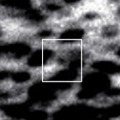
|
It is predicted to keep 16-17 mag for a long time from 2014 summer to early 2016. However, now it is 20.5 mag, much fainter than predicted (May 1, A. Maury, J.-G. Bosch, J.-F. Soulier, T. Noel).
Date(TT) R.A. (2000) Decl. Delta r Elong. m1 Best Time(A, h)
May 24 17 23.33 -27 40.9 2.037 3.009 160 17.7 1:19 ( 0, 27)
May 31 17 17.93 -27 30.2 1.981 2.980 167 17.6 0:46 ( 0, 27)
|

|
Now it is 17.8 mag (Apr. 26, A. Maury, J.-F. Soulier). It has brightened in outburst up to 14 mag twice, in 2006 January and 2011 May. It will pass the perihelion in 2015. It keeps observable at 17 mag for a long time after this.
Date(TT) R.A. (2000) Decl. Delta r Elong. m1 Best Time(A, h)
May 24 21 18.23 -12 19.2 5.700 6.032 104 17.8 3:09 (322, 34)
May 31 21 19.13 -12 13.2 5.587 6.023 110 17.7 3:04 (328, 37)
|

|
First return of a new periodic comet discovered in 2005. It was expected to be observable at 17 mag for a long time from 2013 to 2014. However, it has not been recovered yet. Actually, it is much fainter than predicted, fainter than 20 mag (Aug. 6, Jean-Francois Soulier).
Date(TT) R.A. (2000) Decl. Delta r Elong. m1 Best Time(A, h)
May 24 22 47.13 -8 17.1 3.229 3.256 82 17.8 3:09 (300, 24)
May 31 22 52.60 -7 56.3 3.140 3.263 87 17.8 3:04 (303, 27)
|

|
Now it is 17.9 mag (Apr. 6, Ken-ichi Kadota). It keeps 17 mag for a long time until 2015.
Date(TT) R.A. (2000) Decl. Delta r Elong. m1 Best Time(A, h)
May 24 10 51.23 -5 28.1 3.050 3.429 103 17.8 20:44 ( 41, 41)
May 31 10 54.56 -5 25.4 3.131 3.416 97 17.8 20:51 ( 49, 36)
|

|
Now it is 17.1 mag (Apr. 14, A. Maury, J.-G. Bosch, T. Noel, J.-F. Soulier). It keeps 17-18 mag until June.
Date(TT) R.A. (2000) Decl. Delta r Elong. m1 Best Time(A, h)
May 24 18 42.46 -18 29.0 1.246 2.138 142 17.8 2:38 ( 0, 37)
May 31 18 38.09 -18 27.6 1.234 2.171 149 17.8 2:06 ( 0, 37)
|
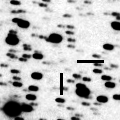
|
Now it is 18.5 mag (Mar. 31, Hidetaka Sato). It is observable at 18 mag in good condition from spring to summer.
Date(TT) R.A. (2000) Decl. Delta r Elong. m1 Best Time(A, h)
May 24 21 13.42 0 9.3 1.502 1.969 101 17.8 3:09 (315, 45)
May 31 21 17.30 2 45.4 1.460 1.992 105 17.8 3:04 (318, 50)
|

|
It brightened up to 12-13 mag from 2012 to 2013. It has already gone away. But it keeps 18 mag for a while, and it will be observable in good condition in the Southern Hemisphere. It will be getting higher gradually also in the Northern Hemisphere.
Date(TT) R.A. (2000) Decl. Delta r Elong. m1 Best Time(A, h)
May 24 0 24.54 -13 14.6 4.061 3.717 63 17.9 3:09 (288, 2)
May 31 0 30.85 -12 56.2 3.990 3.735 68 17.9 3:04 (290, 6)
|
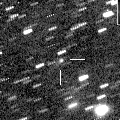
|
Now it is 17.6 mag (May 10, Taras Prystavski). It keeps 18 mag for a long time from 2013 to 2014.
Date(TT) R.A. (2000) Decl. Delta r Elong. m1 Best Time(A, h)
May 24 15 48.78 18 45.8 6.729 7.537 140 17.9 23:40 ( 0, 74)
May 31 15 43.42 19 17.7 6.765 7.542 137 17.9 23:07 ( 0, 74)
|
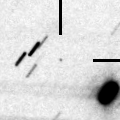
|
Now it is 18.3 mag (May 2, K. Hills). It keeps 18 mag from spring to summer. It is observable in good condition in the Southern Hemisphere. It is not observable in the Northern Hemisphere.
Date(TT) R.A. (2000) Decl. Delta r Elong. m1 Best Time(A, h)
May 24 16 55.71 -63 15.8 0.698 1.593 136 17.9 0:52 ( 0, -8)
May 31 16 46.25 -61 12.1 0.721 1.636 140 18.0 0:15 ( 0, -6)
|

|
Now it is 18.1 mag (Mar. 29, M. Jaeger, W. Vollmann, E. Prosperi, S. Prosperi). It keeps 18 mag for a very long time from 2013 to 2018. It locates high in the Southern Hemisphere. But it locates somewhat low in the Northern Hemisphere.
Date(TT) R.A. (2000) Decl. Delta r Elong. m1 Best Time(A, h)
May 24 10 55.98 -15 56.7 8.931 9.292 107 17.9 20:44 ( 33, 32)
May 31 10 56.76 -15 43.1 9.028 9.287 101 18.0 20:51 ( 41, 28)
|

|
Now it is 19.4 mag (May 3, A. Waszczak). First return of a new periodic comet which brightened up to 13 mag in outburst in 2008. It will be observable in good condition from spring to summer. However, it will be only 19-20 mag at best in this apparition.
Date(TT) R.A. (2000) Decl. Delta r Elong. m1 Best Time(A, h)
May 24 12 11.75 13 23.2 1.831 2.426 113 19.6 20:44 ( 25, 66)
May 31 12 14.30 12 25.5 1.894 2.415 108 19.6 20:51 ( 40, 62)
|
|
![]()
 P/2014 E1 ( Larson )
P/2014 E1 ( Larson ) 181P/Shoemaker-Levy 6
181P/Shoemaker-Levy 6 C/2011 KP36 ( Spacewatch )
C/2011 KP36 ( Spacewatch ) C/2012 K6 ( McNaught )
C/2012 K6 ( McNaught ) C/2013 US10 ( Catalina )
C/2013 US10 ( Catalina ) C/2013 G3 ( PanSTARRS )
C/2013 G3 ( PanSTARRS ) C/2012 K8 ( Lemmon )
C/2012 K8 ( Lemmon ) C/2013 G9 ( Tenagra )
C/2013 G9 ( Tenagra ) 280P/2013 C1 ( Larsen )
280P/2013 C1 ( Larsen ) 124P/Mrkos
124P/Mrkos C/2013 G7 ( McNaught )
C/2013 G7 ( McNaught ) 284P/2013 J1 ( McNaught )
284P/2013 J1 ( McNaught ) C/2012 V2 ( LINEAR )
C/2012 V2 ( LINEAR ) 210P/Christensen
210P/Christensen 44P/Reinmuth 2
44P/Reinmuth 2 174P/(60558) 2000 EC98 ( Echeclus )
174P/(60558) 2000 EC98 ( Echeclus ) P/2005 L1 ( McNaught )
P/2005 L1 ( McNaught ) 299P/2014 D2 ( Catalina-PanSTARRS )
299P/2014 D2 ( Catalina-PanSTARRS ) P/2014 C1 ( TOTAS )
P/2014 C1 ( TOTAS ) 296P/2014 A1 ( Garradd )
296P/2014 A1 ( Garradd ) 246P/2010 V2 ( NEAT )
246P/2010 V2 ( NEAT ) C/2013 H2 ( Boattini )
C/2013 H2 ( Boattini ) 294P/2013 X2 ( LINEAR )
294P/2013 X2 ( LINEAR ) C/2013 C2 ( Tenagra )
C/2013 C2 ( Tenagra ) 297P/2014 D1 ( Beshore )
297P/2014 D1 ( Beshore )![]()















































